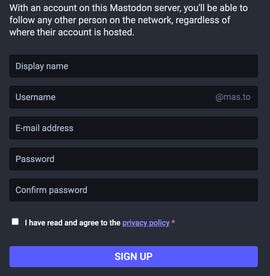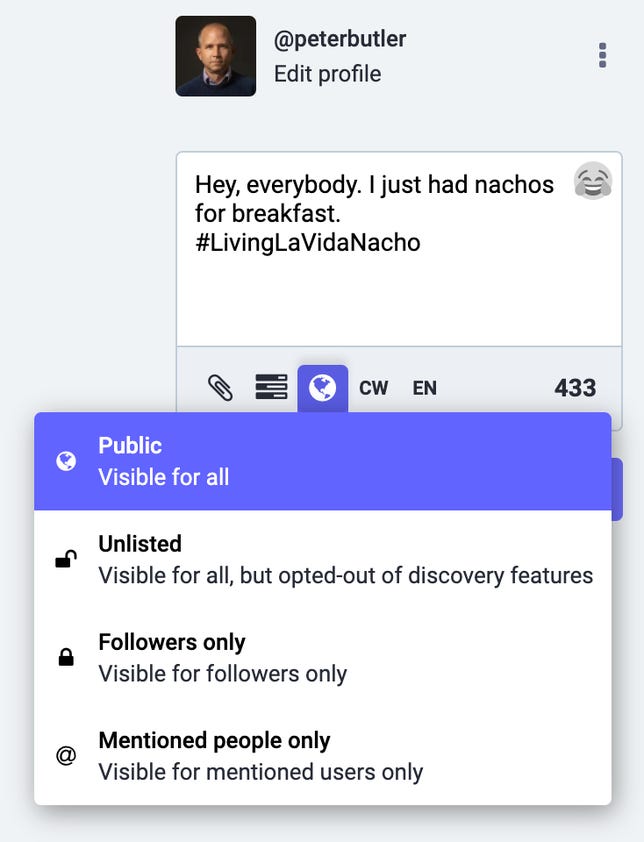Since Elon Musk took control of Twitter on Oct. 27, the social network has been roiled by controversy. First, half the staff was laid off via email, and an ill-advised new implementation of its “blue check” verification system left the site plagued by trolls and fake “verified” accounts. Now, Twitter has banned accounts that Musk promised to protect and suspended several prominent journalists who report on Elon Musk.
Twitters users concerned about changes at the company are looking for other social media options, and the open-source network Mastodon has been a big beneficiary. Mastodon Count, a bot that tracks usage on the network, showed a 400% increase in the rate of new account sign-ups on Dec. 15, when Twitter suspended the journalists who cover Musk.


Mastodon’s creator responded to his Twitter suspension with humor.
Screenshot by Peter Butler/CNETThe growing popularity of Mastodon might partly explain why Twitter is now blocking many links to Mastodon servers and suggesting the URLs are “harmful” or include malware. Twitter has also suspended the official account for Mastodon, prompting a joke from creator Eugen Rochko about never having to check Twitter notifications again.
Read on to see how Mastodon works, how to sign up, and how it compares to Twitter. For more, see how to delete your Twitter account, and get the latest on Twitter’s verification badge plans.
What is Mastodon and how is it different from Twitter?
Mastodon is a free social media service that functions much like Twitter. You can post “toots” (instead of tweets), follow other people and organizations, and favorite (like) and boost (retweet) posts from other people.
Mastodon was created and originally released in October 2016 by Eugen Rochko, the CEO and lone employee of the nonprofit organization Mastodon gGmbH. In May, Rochko explained the service’s oddly named substitute for “tweet.” He says the original button was called “publish,” but a committed supporter promised lifetime support of the Mastodon Patreon account if he would change it to “toot.” (On the iOS and Android apps it says “publish.”)
In an interview with Time Magazine, Rochko said he began developing Mastodon when he realized that “being able to express myself online to my friends through short messages was actually very important to me, important also to the world, and that maybe it should not be in the hands of a single corporation that can just do whatever it wants with it.”
Read more: Mastodon Is No Twitter Replacement
Instead of one town square for everyone, however, Mastodon is composed of thousands of social networks, all running on different servers, or “instances,” that can communicate with each other through a system called the Fediverse. The Fediverse also contains other social networks like PeerTube for videos, Funkwhale for music, PixelFed for photos and NextCloud for files.
Mastodon servers aren’t required to be connected to the Fediverse, In fact, the most famous Mastodon instance is Truth Social, the social network of former US President Donald Trump.
How do I join Mastodon?
The hardest part of Mastodon is getting started. Since there’s no one common Mastodon area for everyone — as with Twitter — you’ll need to register on a specific Mastodon server.
Servers can be based on a geographic location, subject interest, professional background or literally anything an administrator can think of. For example, the folks at dolphin.town are only allowed to post the letter “E,” while the literary buffs at oulipo.social are forbidden from ever using the letter “E” (in honor of OuLiPo writer Georges Perec’s lipogram “La Disparition“).
Two of the biggest Mastodon servers, aka instances, are mastodon.social — the official server of the Mastodon project — and mstdn.social, though both have temporarily paused registrations. Another large general server that I recently joined is mas.to. Other popular Mastodon instances include masthead.social for journalists and fosstodon.org for open-source software.
Don’t worry too much about which server you pick — you can join as many as you want and leave or switch servers at any time. And you can follow people across servers, so picking one doesn’t keep you from communicating with those on other instances.
One good place to find a server to join is the official Mastodon website at joinmastodon.org. The site currently lists about 80 servers that have committed to the Mastodon Server Covenant, an agreement to enforce moderation, make backups of the site and give at least three months warning before ever shutting down an instance.
Each server’s “about” page will tell a little bit about the Mastodon instance and list the server’s rules. If you don’t find a server that you like on joinmastodon.org, you can try other Mastodon directories, such as instances.social, which offers a wizard for picking a server as well as a sortable list of 16,412 instances.


Joining a Mastodon server only requires a few personal details.
Screenshot by Peter Butler/CNETMost Mastodon servers with open registration will only ask for your email address and a password to get started. Once you respond to a verification email, you’re ready to start using Mastodon. Other, more private Mastodon servers may ask you to make a request to join and then wait for an invitation.
How do I use Mastodon?
Like Twitter, Mastodon lets you post short messages to the world or to select people, but instead of tweets, Mastodon posts are called toots. And many of Mastodon’s other features are a lot like Twitter’s, too, with slight differences. Each post is limited to 500 characters (instead of 280), and you can include links, images (JPG, GIF or PNG, up to 8MB), audio files (MP3, OGG, WAV, FLAC, OPUS, AAC, M4A and 3GP up to 40MB) and videos (MP4, M4V, MOV, WebM up to 40MB).


Mastodon offers four levels of visibility for all of your toots.
Screenshot by Peter Butler/CNETYour posts on Mastodon can be set to be public, only for your followers or completely unlisted from all timelines. You can create polls for your followers and use all your favorite usual emojis, plus custom emojis created for specific servers.
Any post can be marked with an explanatory “content warning” that requires a click before viewing, and Mastodon users take advantage of the feature often.
You can even edit posts on Mastodon. Each version of your toot remains available for review, and people who reblog your post are notified after it’s edited.
Just like Twitter, Mastodon uses hashtags that start with the “#” symbol, such as #Gaming, #Anthropology or #Veganism. Since there’s no algorithm to suggest your posts to nonfollowers, using hashtags to categorize your posts for people who might be interested is even more important than on Twitter.
You can follow any account on Mastodon, whether or not it’s on your own server instance, and the account’s posts will be added to your Home feed in chronological order. Know that for some accounts, you need to request permission to follow them.
Free web apps like Debirdify, Fedifinder and Twitodon can help you find accounts you followed on Twitter that have migrated to Mastodon.
If you don’t want a particular account following you, you can block them just like on Twitter, or you can choose to block an entire server.
Mastodon lets you “favorite” posts, but the favorites count doesn’t appear on timelines — if you want to promote someone else’s posts, you’ll need to “boost” or reblog them. Unlike Twitter, there are no “quote toots” on Mastodon, a deliberate choice to discourage “dunking” on other people’s posts. A separate “bookmark” feature lets you save toots on Mastodon without notifying the account that posted it.
Mastodon does have a feature called Direct Messages, but the name is a little misleading. Rather than providing person-to-person messages, Mastodon’s feature sets the visibility of a post to only the people mentioned in it. In other words, they’re toots that only certain people can see, rather than actual direct messages.
How do the Mastodon timelines work?
Whereas Twitter just has one timeline (sorted chronologically or by “top stories”), Mastodon has three: your Home timeline shows all the posts and reblogs from everyone you follow, your Local timeline shows everything from your own server instance, and your Federated timeline shows all posts from all Mastodon servers on which you follow someone.
Using a web browser, you can set Mastodon to look like Twitter, showing one feed at a time, or you can view multiple feeds and notifications simultaneously (much like Tweetdeck) by selecting “Advanced view” from your Preferences.


Mastodon’s advanced view lets you view notifications and multiple timelines simultaneously.
Screenshot by Peter Butler/CNETAre there any mobile apps for Mastodon?
You bet. Due to the open-source nature of Mastodon, you have a lot of choices for apps on both iPhone and Android.
Your first and easiest option is the official app from Mastodon gGmbH (for iOS or Android), but there are other solid third-party apps. The two most popular alternative Mastodon apps right now are Metatext for iPhone and Tusky for Android.
Mastodon apps for iPhone:
Mastodon apps for Android:
If you do get started with Mastodon, make sure to follow me @peterbutler@mas.to. (And say hello!)
For more about social media and Twitter, follow a timeline of the Elon Musk purchase and read about the big changes that could be in store for Twitter.
Correction, Nov. 7: A previous version of this story incorrectly described Mastodon’s features. Mastodon added the ability to edit posts in March 2022.
